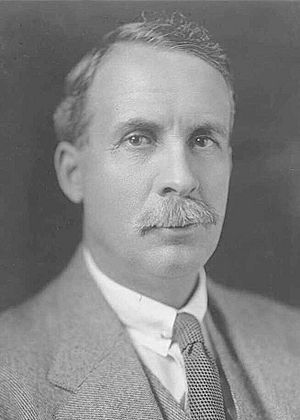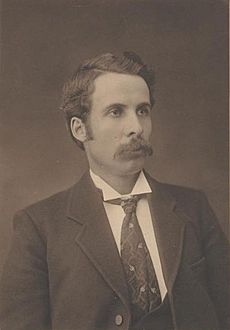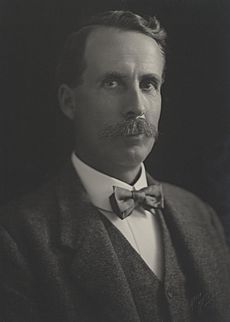George Pearce facts for kids
Quick facts for kids
Sir George Pearce
|
|
|---|---|

Pearce, c. 1915
|
|
| Minister for External Affairs | |
| In office 12 October 1934 – 29 November 1937 |
|
| Prime Minister | Joseph Lyons |
| Preceded by | John Latham |
| Succeeded by | Billy Hughes |
| Minister for Defence | |
| In office 6 January 1932 – 12 October 1934 |
|
| Prime Minister | Joseph Lyons |
| Preceded by | Ben Chifley |
| Succeeded by | Archdale Parkhill |
| In office 17 September 1914 – 21 December 1921 |
|
| Prime Minister | Andrew Fisher Billy Hughes |
| Preceded by | Edward Millen |
| Succeeded by | Walter Massy-Greene |
| In office 29 April 1910 – 24 June 1913 |
|
| Prime Minister | Andrew Fisher |
| Preceded by | Joseph Cook |
| Succeeded by | Edward Millen |
| In office 13 November 1908 – 2 June 1909 |
|
| Prime Minister | Andrew Fisher |
| Preceded by | Thomas Ewing |
| Succeeded by | Joseph Cook |
| Minister for Home and Territories | |
| In office 21 December 1921 – 18 June 1926 |
|
| Prime Minister | Billy Hughes Stanley Bruce |
| Preceded by | Alexander Poynton |
| Succeeded by | William Glasgow |
| Senator for Western Australia | |
| In office 29 March 1901 – 30 June 1938 |
|
| Preceded by | Position established |
| Succeeded by | Robert Clothier |
| Personal details | |
| Born |
George Foster Pearce
14 January 1870 Mount Barker, Province of South Australia, British Empire |
| Died | 24 June 1952 (aged 82) Elwood, Victoria, Australia |
| Political party |
|
| Spouse |
Eliza Barrett
(m. 1897) |
| Occupation | Carpenter |
| Signature | |
Sir George Foster Pearce (born January 14, 1870 – died June 24, 1952) was an important Australian politician. He served as a Senator for Western Australia for a very long time, from 1901 to 1938. A Senator is a member of the upper house of the Australian Parliament.
George Pearce started his political journey with the Labor Party. However, he later joined three other political parties: the National Labor Party, the Nationalist Party, and the United Australia Party. He was a cabinet minister under prime ministers from all these parties. A cabinet minister is a senior member of the government, in charge of a specific department.
Pearce was born in Mount Barker, South Australia. He left school at age 11 and became a carpenter. He then moved to Western Australia and got involved in the union movement, which works to protect workers' rights. He helped start the Labor Party there. In 1901, at 31, he was elected to the new federal parliament.
He became a cabinet minister in 1908 under Prime Minister Andrew Fisher. He continued to serve in the cabinet under Billy Hughes and Stanley Bruce. After joining the United Australia Party in 1931, he also served under Joseph Lyons. He was the Minister for Defence several times. His 24 years in cabinet and 37 years as a senator are both Australian records!
Contents
Early Life and Work
George Pearce was born in Mount Barker, South Australia. He was the fifth of eleven children. His father was a blacksmith, and his mother was from London. George grew up in a small town called Redhill. He went to the local public school.
He left school when he was only 11 years old. He started working on farms. Later, he became a carpenter's apprentice, learning the trade. After finishing his training, he moved to Adelaide. However, it was hard to find work there in the early 1890s because of a tough economy.
In 1893, Pearce moved to Coolgardie, Western Australia. He hoped to find gold during the gold rush, but he wasn't very successful. He then settled in Perth and went back to being a carpenter. He joined a union called the Amalgamated Society of Carpenters and Joiners. He became a leader in the local labour movement. In 1897, he led a strike at building sites. This caused him to be "blacklisted" for several weeks, meaning he couldn't find work. On April 4, 1897, George Pearce married Eliza Maud Barrett. They had two sons and two daughters. His great-granddaughter, Jane Prentice, also became a federal politician in 2010.
Starting His Political Journey
In 1893, George Pearce helped start the Progressive Political League. This group was an early version of the Labor Party in Western Australia. He taught himself a lot about politics and money. In 1901, he was elected as a Senator for Western Australia in the first ever Commonwealth Parliament.
He almost became a member of the first Labor Party Cabinet in 1904. This was when Chris Watson became Prime Minister. From 1907 to 1908, Pearce was the Chairman of Committees in the Senate. This role helps manage the Senate's work.
In 1908, the Labor Party chose Pearce to join the cabinet. He had always been interested in defence, so Prime Minister Andrew Fisher made him the Minister for Defence. He believed his job was to approve "any reasonable spending" on weapons and equipment. During his first time as minister, Pearce ordered three River-class torpedo-boat destroyers. These were warships for what would become the Royal Australian Navy.
Pearce became Defence Minister again from 1910 to 1913. During this time, he helped create the Naval Defence Act 1910. This law set up the Australian Commonwealth Naval Board and the Royal Australian Naval College. He also went to a big meeting in London in 1911. There, they decided how the Royal Australian Navy would work with the British Royal Navy. He also helped start a compulsory military training program. In 1912, he approved the creation of the Central Flying School in Victoria. This place became known as the "birthplace of Australian military aviation."
World War I and Changing Parties
In 1914, Australia joined World War I. When Billy Hughes became Prime Minister, Pearce was made the Deputy Leader of the party.
Pearce was the acting prime minister from January to August 1916. This happened while Hughes was away in England and France. He was the first senator to ever hold this important role. Besides defence, Pearce helped create the Advisory Council of Science and Industry. This group later became the CSIRO, which does important scientific research. In March 1916, he used a special law to control the prices of bread and flour. He later extended this to all other foods and created a commission to set prices on anything needed.
When Prime Minister Hughes returned, there was a big disagreement in the Labor Party about whether Australia should force people to join the army (called conscription). Pearce believed conscription was necessary, but most of his party disagreed. So, Pearce and many other founding members left the Labor Party with Hughes. They formed a new group called the "National Labor Party." A few months later, this new party joined with another party to form the Nationalist Party. Hughes became its leader.
After the War
Many politicians who left the Labor Party with Hughes were not heard from much again. But Pearce continued to have a very successful career with the Nationalists. After Hughes was no longer the leader, Pearce joined the government of the next Prime Minister, Stanley Bruce.
As Minister for Home and Territories, he was very interested in the Northern Territory. He was the main person behind dividing it into two separate territories in 1927. These were Central Australia and North Australia. This change was later reversed in 1931. In 1923, he became the first "Father of the Senate". This title is given to the longest-serving senator. In 1927, he was given a special honour and became a Knight Commander of the Royal Victorian Order (KCVO).
In 1932, Pearce joined the new United Australia Party. He served as a minister in the government of Joseph Lyons. He stayed in this role until he lost his seat in the 1937 election. His term as Senator officially ended in June 1938.
Pearce also campaigned against Western Australia leaving Australia in 1933. Even though most people in Western Australia voted to leave, it didn't happen. In the 1937 election, groups who wanted Western Australia to leave campaigned against Pearce. Their campaign, called "Put Pearce Last," worked. He lost his seat. He had been a senator for 37 years and three months, which is a record! His total time as a minister was 24 years and seven months, also a record in the Australian Parliament.
Later Life and Legacy
After losing his seat in parliament, George Pearce did not try to get back in. He worked on the Commonwealth Grants Commission from 1939 to 1944. He also chaired the Defence Board of Business Administration from 1940 until 1947. This board oversaw all large defence spending. Even though some people in the Labor Party didn't want him there, Prime Minister John Curtin kept him in this important role.
Pearce mostly lived in Melbourne, but he owned a farm in Tenterden, Western Australia, with his son and visited often. In 1951, he published his autobiography, Carpenter to Cabinet. He died at his home in Elwood on June 24, 1952, when he was 82 years old. At the time of his death, he was the last living member of the first Senate.
Many places are named after George Pearce to honour him. These include RAAF Base Pearce, which is an air force base, and the electoral Division of Pearce in Western Australia. There is also Pearce Peak in Antarctica and a suburb in Canberra called Pearce.
Australia's longest-serving prime minister, Robert Menzies, wrote about Pearce in a book. Menzies said he had "never sat with an abler man than George Pearce" in cabinet. He praised Pearce's "profound and reflective mind" and his ability to think clearly and share his ideas.
Images for kids
See also
 In Spanish: George Pearce para niños
In Spanish: George Pearce para niños





